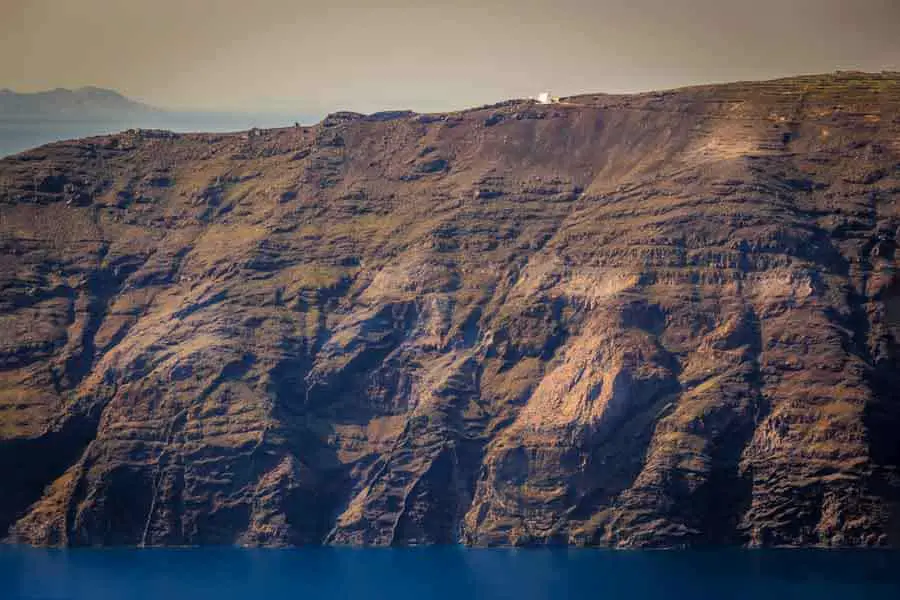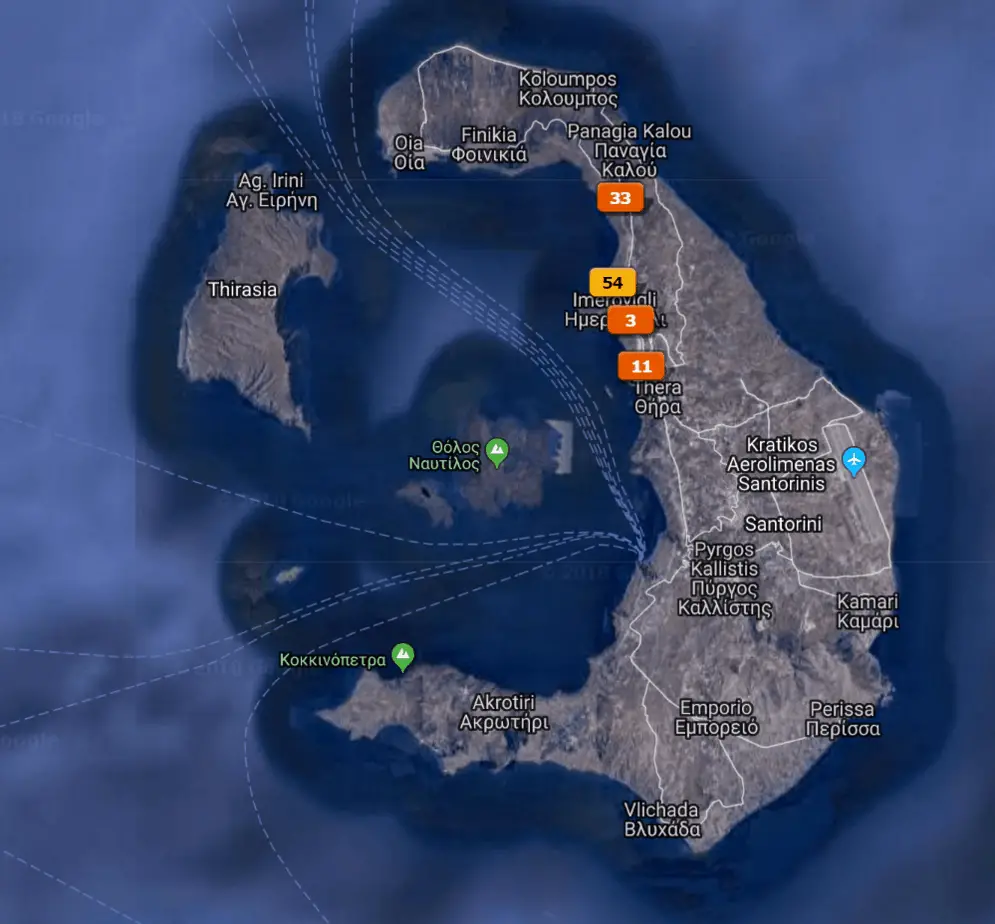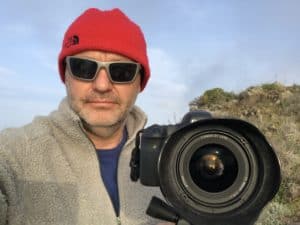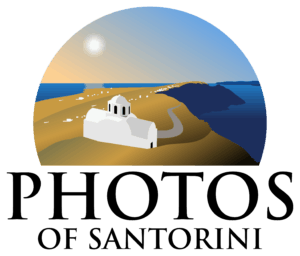
I was excited to get to Santorini to explore and photograph the wonderful landscape created by a volcanic eruption years ago.
And there was a question I had asked myself before I arrived – how high is the Santorini caldera? This photo shows how high it is. Ok well it doesn’t, but it gives you an idea of the scale.
And in actual numbers, the highest point of the Santorini caldera is 367 metres high (which in old money is 1,204 feet).
Why do I like this photo so much?
The simplicity of the image. The mass of the caldera and one small white building on the top.
And the fact that it was visually answering the question “how high is the Santorini caldera?” – one of the questions I took with me in my confused head all the way from England to the stunning Greek Island of Santorini.
This contrast is a metaphor for the relative stature of humans and the planet, the natural world against the man made world.
I sometimes include people in my photos is to provide a sense of scale – here the small white church does just that.
How did I decide on this composition?
When I am out on a location shoot I look all around me to see what other possible compositions there are. I often do this once I have made my sunrise composition and am sat there waiting for the sun to rise.
Once I have captured a sunrise that is that image capture done. I move on to the next thing. And that includes taking advantage of that early morning directional light giving scenes like this depth and dimension.
And of course possible compositions for later in the day.
I actually spotted this church as I was walking away from the sunrise shoot, and was rather taken with the view, but the light was not right at the time.
I returned after lunch, and the sun had moved round enough to give some pleasing light.
The white church was prominently illuminated by the early afternoon sun. It was then that I was struck by the significance of the one white building – when I looked at the composition on my LCD screen the white building stood out, whilst at the same time looking so insignificant and small.
This was the point of interest for me in this composition – the tiny white Greek Church dwarfed by the caldera formed by a volcanic eruption years ago. This picture answered that question nicely for me.
And the picture also conveyes the precarious nature of the development of Santorini – small buildings placed on the top of that massive natural structure.
Where was the photo taken?
Right there where the number 54 is. Yes this was a great location clearly.

What time of day was the photo taken?
Twenty past two in the afternoon. This part of the caldera was in shade at sunrise but by early afternoon the sun had moved around enough that the light was directional enough to give the shadows you can see. At sunset this part of the caldera would be in shade.
This puts paid to the incorrect general view that you should only shoot in the hours around sunrise and sunset – utter nonsense. You should shoot any scene at the time at which the light works to compliment the scene.
Or at the time when you can get there – life is not that simple for us mere mortals.
What photography gear did I use to get the shot
- Canon 6D
- Canon 70-200mm F4 L lens
- My hands
- Loupe viewer
- Red shoes
- Water
- No hat required
What camera settings did I use?
- Aperture – F8
- Shutter speed – 1/1000th second
- ISO 400
- Focal length – 169mm
- AV Mode
- Back button focus
- Single image capture
- Hand held
One interesting fact about the image.
It was taken after lunch. Not long after 2pm, when the sun is at its highest. And it’s hotter! I really noticed that.
Yes the time they all say you shouldn’t be taking photos, with that flat dull overhead lighting.
And also the fact that I used my telephoto lens for this shot. I normally carry it around paired with my 17-40mm lens for scenes just like this one.
Is there a behind the scenes video of this shoot?
No – not for this shot. I was getting rather tired, as I had been on my feet since 4am without any kind of break. I had a beer when I got back and a little sleep before sunset though!
The shot was hendheld – not even I can video myself taking a photo handheld! Well I could have used my tripod….
And this is an ever rarer shot being a single image and not an HDR capture.
How did I process the image?
Well I was starting with a single image, so I had to make it look and feel like the other images in this set – I didn’t want it to stand out or look different.
I did global adjustments in the Basic Panel in Lightroom, and then local adjustments, mainly dodging and burning.
I dodged the white building, giving an exposure increase and moving the whites slider to the right.
I dodged and burned parts of the face of the caldera to emphasize the lights and the darks, giving the image more dimension and depth.
Dodging and burning is the term used to selectively lighten (dodging) or darken (burning) parts of an image. The term originated in the film days, and was a technique used in printing.
What could I have done to improve the image?
If I had lowered my camera slightly I could have excluded the island in the background, which I believe is the small Greek Island called Sikinos.
Sure I could remove this in Photoshop, but I haven’t done so as this was the scene I photographed. I only tend to remove blemishes and imcomplete things in Photoshop, not whole islands. And every now and then I have to add things in after a drastic correction of the horizon!
And I could have taken the shot in portrait mode, zooming in more to make more of the relative sizes of the caldera and the church.
That would have not necessarily made for a better image, but would have given a different perspective.
I used my telephoto lens, using a focal length of 169mm. It is easy to forget that one of the best lenses for landscape photography is actually a telephoto lens.
And what are my thoughts on this image?
It works for me. I wanted to convey the scale of the caldera, which I have done I feel with the inclusion of one white Greek Church.
It is a single image catpure, fine for daylight shooting where there is slightly less dynamic range to capture.
And this photo visually answered the question about the height of the Santorini caldera.
Enough of me – what do you think of this image?
Please let me know your thoughts on this image – have I achieved the objective I set out to achieve? have I conveyed what I have written about in this post?
One last thing
If you want to buy this image, or want to speak to me about future collaboration email me at sales@rickmcevoyphotography.co.uk.
Rick McEvoy ABIPP – Photographer, writer, blogger
